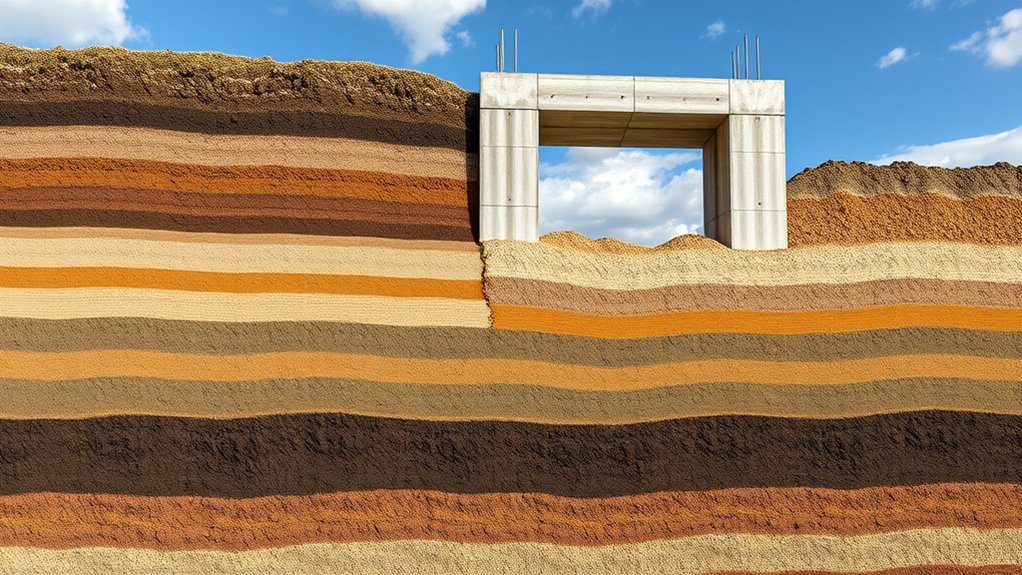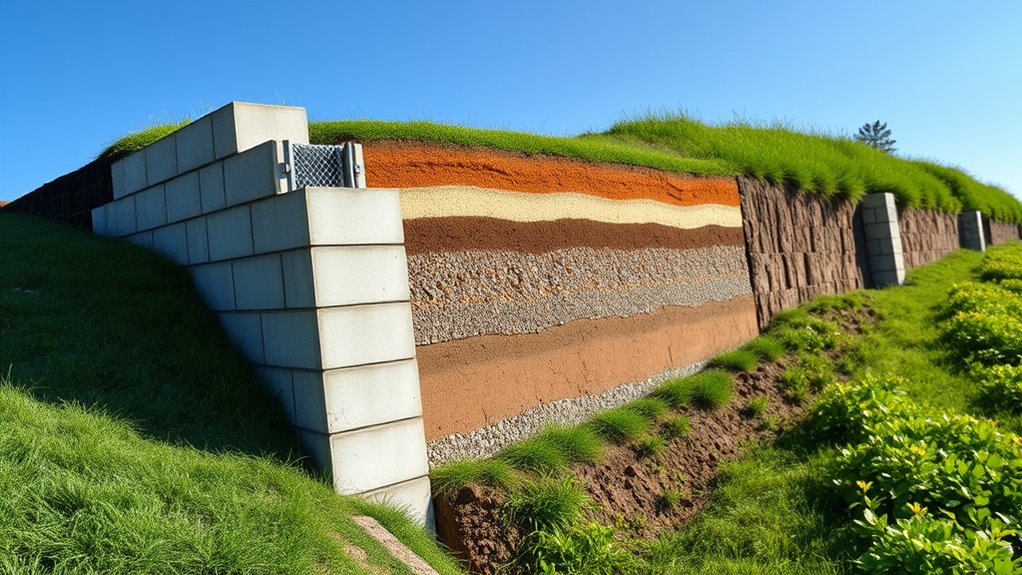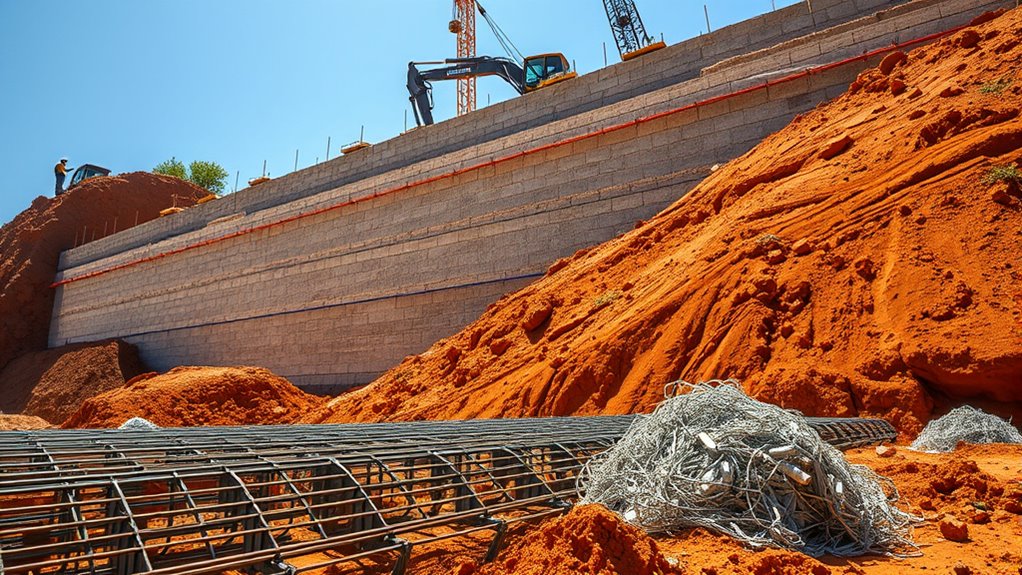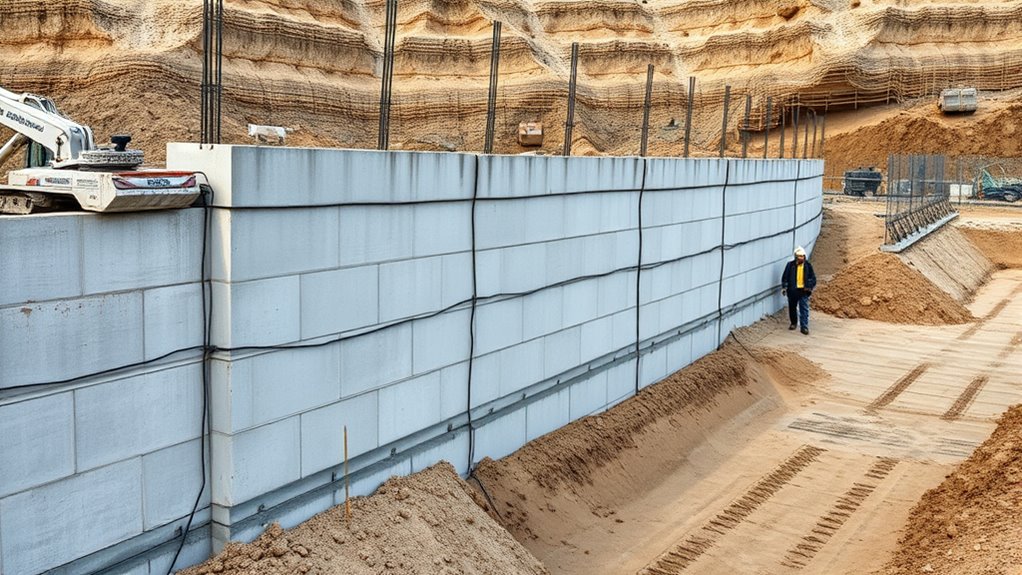Understanding soil properties like strength, permeability, and type helps you design stable foundations and slopes. Choosing the right retaining wall—gravity, cantilever, or sheet pile—depends on site conditions and load demands. You can reinforce and stabilize soil with techniques like grouting, geosynthetics, and proper drainage to prevent issues like erosion or settlement. Mastering these essentials guarantees long-term stability; keep exploring to learn how these strategies work together for safe, durable structures.
Key Takeaways
- Understanding soil types, properties, and behavior is essential for designing effective stabilization and support systems.
- Selecting appropriate retaining wall types (gravity, cantilever, sheet pile) ensures stability based on site conditions.
- Reinforcement techniques like geogrids, soil nails, and proper drainage improve ground support and longevity.
- Addressing soil stability challenges involves proper drainage, compaction, and stabilization methods such as grouting or chemical binders.
- Continuous monitoring, maintenance, and backup power systems are vital for long-term geotechnical stability and safety.
Understanding Soil Properties and Behavior

Understanding soil properties and behavior is essential for designing safe and effective foundations. Your first step is to assess how soils respond to loads, moisture, and environmental changes. You need to identify whether the soil is cohesive or cohesionless, as this influences its stability and drainage. Soil tests, like grain size analysis and shear strength measurements, give you crucial data. Pay attention to properties such as compaction, permeability, and plasticity, which affect how the soil behaves under different conditions. Recognizing these characteristics helps you predict potential issues like settling, sliding, or collapse. For example, the ability to make juice blends with tropical fruits and herbs can inspire innovative solutions for environmental challenges. By thoroughly understanding soil behavior, you can select the right foundation type and design measures that ensure safety, durability, and cost-efficiency in your construction project.
Types and Functions of Retaining Walls

Retaining walls serve a critical function in managing soil and preventing erosion or collapse in sloped terrains. They come in various types, each suited for different situations. Gravity walls rely on their weight to hold back soil, ideal for larger heights. Cantilever walls use reinforced concrete and leverage soil pressure, making them suitable for medium heights. Sheet pile walls employ steel or vinyl sheets driven into the ground, perfect for tight spaces or temporary support. The table below highlights these types:
| Type | Material | Common Use |
|---|---|---|
| Gravity | Concrete, stone | Heavy, large-scale projects |
| Cantilever | Reinforced concrete | Medium heights, urban areas |
| Sheet Pile | Steel, vinyl | Shallow depths, tight spaces |
Choosing the right type guarantees stability and longevity. Additionally, understanding the power requirements of supporting appliances can be essential for safe and effective installation and operation.
Design Principles for Effective Retaining Structures

To guarantee your retaining structure performs effectively and remains stable over time, you must follow key design principles that address both safety and durability. First, ensure your design properly manages lateral earth pressure by incorporating appropriate wall height and reinforcement. Use suitable materials that withstand environmental conditions and load stresses. Incorporate proper drainage solutions to prevent water buildup, which can weaken the structure. Maintain adequate footing and foundation stability by considering soil type and bearing capacity. Design for load distribution, avoiding overstressing any component. Regularly inspect and plan for maintenance to identify potential issues early. Additionally, understanding retaining wall hours can help coordinate construction or inspection schedules to ensure timely maintenance and safety. By following these principles, you create a reliable, long-lasting retaining structure that protects your property and ensures safety.
Techniques for Soil Stabilization and Reinforcement

You can improve soil stability by applying various stabilization methods, such as chemical, mechanical, or biological techniques. Reinforcement options like geogrids, soil nails, and geotextiles help strengthen and support the ground. Understanding these techniques allows you to select the best approach for your project’s specific needs. Incorporating proper nutrition into soil management practices can also enhance the effectiveness of stabilization efforts.
Soil Stabilization Methods
Soil stabilization methods are essential techniques used to improve the strength, durability, and stability of soil for construction projects. You can enhance soil properties by adding binders like lime, cement, or fly ash, which chemically react with soil particles to improve cohesion. Mechanical methods, such as compaction, densify the soil and reduce voids, increasing load-bearing capacity. You might also use chemical stabilizers, like emulsions or stabilizing agents, to improve workability and strength. Geosynthetics, including geogrids and geotextiles, reinforce the soil by distributing loads and controlling deformation. Additionally, stabilization can involve moisture control, such as drainage systems, to prevent erosion or swelling. These techniques help create a stable foundation, minimizing future settlement and ensuring the safety of your construction project. Incorporating high-quality materials can further optimize the effectiveness of soil stabilization efforts.
Reinforcement Techniques
Reinforcement techniques build on soil stabilization methods by adding structural support to enhance soil strength and stability. They help prevent failures and improve load-bearing capacity. Here are four common reinforcement methods you might consider:
- Geogrids – These are synthetic grids placed within soil layers to distribute loads and reinforce weak soils.
- Geotextiles – Permeable fabrics that separate, reinforce, and filter soil, often used beneath pavements.
- Soil nails – Steel bars inserted into slopes or retaining walls to hold soil in place and prevent sliding.
- Micropiles – Small-diameter piles driven into the ground to reinforce foundations or unstable soils.
Using these techniques, you’ll strengthen soil structures, ensuring safety and durability in your projects.
Common Challenges and Solutions in Geotechnical Projects

Soil instability is a common challenge you’ll face in geotechnical projects, often caused by poor drainage, erosion, or uneven load distribution. To address this, effective stabilization techniques like soil mixing, grouting, and reinforcement can help you create a more stable foundation. Understanding these causes and solutions is key to preventing costly failures and ensuring project success. Additionally, selecting the right type of dog names can improve team morale on construction sites or foster better client relationships.
Soil Instability Causes
What often causes instability in geotechnical projects? Several factors can lead to soil failure. First, inadequate drainage allows water to accumulate, reducing soil strength and increasing pressure. Second, improper compaction leaves voids that weaken the soil structure. Third, changes in moisture content—either too wet or too dry—can cause soil to swell or shrink, destabilizing slopes. Lastly, natural events like earthquakes or heavy rainfall can trigger landslides or erosion. Recognizing these causes helps you identify potential risks early. Addressing drainage issues, ensuring proper compaction, managing moisture levels, and monitoring environmental conditions are vital steps. By understanding these common challenges, you can implement better strategies to maintain soil stability and prevent costly failures in your projects.
Effective Stabilization Techniques
Have you ever wondered how engineers effectively stabilize unstable ground in geotechnical projects? They use proven techniques to address soil weaknesses and prevent failure. Methods like soil reinforcement, grouting, and drainage improve stability. Soil reinforcement involves adding geosynthetics or compaction to strengthen the ground. Grouting injects cement or chemical solutions to fill voids and bind particles. Proper drainage systems divert water, reducing soil erosion and pressure. Sometimes, installing retaining walls or soil nails provides additional support. The key is selecting the right technique based on soil type, load requirements, and site conditions. Incorporating safe backup systems such as generators and power stations can ensure continuous operation during outages, which is especially important for critical stabilization equipment. By understanding and applying these effective stabilization methods, you can overcome common challenges, ensuring safety and longevity in your project.
Best Practices for Ensuring Long-Term Stability

Ensuring long-term stability requires implementing proven practices that address both current conditions and future risks. To do this effectively, you should focus on proactive measures that prevent issues before they arise. First, regularly inspect and monitor your structures and soil conditions to catch early signs of movement or deterioration. Second, use high-quality materials and construction techniques that meet industry standards, ensuring durability. Third, plan for future load changes and environmental shifts by designing adaptable systems. Ultimately, maintain good drainage to prevent water buildup, which can weaken soil and structures over time. Incorporating soil stabilization techniques can significantly enhance the overall resilience of your project. These steps help you reduce the likelihood of failures and extend the lifespan of your geotechnical projects, giving you confidence in their long-term stability.
Frequently Asked Questions
How Do Environmental Factors Influence Soil Stability Over Time?
Environmental factors substantially impact soil stability over time. You notice that heavy rainfall can cause erosion, weakening the soil structure. Freeze-thaw cycles expand and contract the soil, leading to cracks and instability. Vegetation roots can either stabilize or destabilize the soil depending on their growth patterns. Additionally, human activities like construction or deforestation alter natural conditions, making soil more susceptible to shifting and failure. Staying aware of these factors helps you manage and mitigate potential risks.
What Are the Latest Innovations in Retaining Wall Materials?
You should consider modern materials like fiber-reinforced concrete, which offers increased strength and durability, or modular block systems that simplify installation and adaptability. Innovations also include geosynthetic reinforcements, which enhance stability while reducing costs, and environmentally friendly options like recycled plastic or bio-based materials that promote sustainability. These advanced materials improve performance, extend lifespan, and allow for more creative, efficient designs in retaining wall construction.
How Does Climate Change Impact Soil Reinforcement Techniques?
You should know that climate change is increasing extreme weather events, which directly impacts soil reinforcement techniques. For example, heavy rainfall can cause erosion or weaken soil structures, making reinforcement less effective. As a result, you might need to adapt your strategies by incorporating more resilient materials or designing for greater stability. Staying ahead of these changes guarantees your projects remain safe and durable despite the evolving climate challenges.
What Are Cost-Effective Methods for Large-Scale Soil Stabilization?
You can utilize cost-effective methods like soil stabilization through cheap, readily available materials such as lime, cement, or fly ash. Incorporate geosynthetics like geogrids or geotextiles to reinforce soil efficiently. Employ mechanical stabilization techniques, including compaction and stabilization with locally sourced fill. Additionally, consider biological methods like planting deep-rooted vegetation to improve soil strength naturally, reducing long-term costs and environmental impact.
How Can Remote Sensing Improve Geotechnical Site Assessments?
Remote sensing enhances your geotechnical site assessments by providing rapid, large-area data collection without physical intrusion. You can use satellite imagery and aerial drones to identify soil types, moisture levels, and surface features efficiently. This technology helps you detect potential hazards early, monitor changes over time, and plan more accurate, cost-effective interventions. By integrating remote sensing, you improve your decision-making process and reduce the need for extensive on-site investigations.
Conclusion
By mastering soil properties, choosing the right retaining wall, and applying proper stabilization techniques, you set the stage for long-lasting success—think of it as your own personal “DeLorean” for modern geotechnical mastery. Keep challenges in check with best practices, and you’ll guarantee stability that stands the test of time. Remember, understanding these essentials is your ticket to building safe, durable structures—no flux capacitor required!










